Physical Address
304 North Cardinal St.
Dorchester Center, MA 02124
Physical Address
304 North Cardinal St.
Dorchester Center, MA 02124
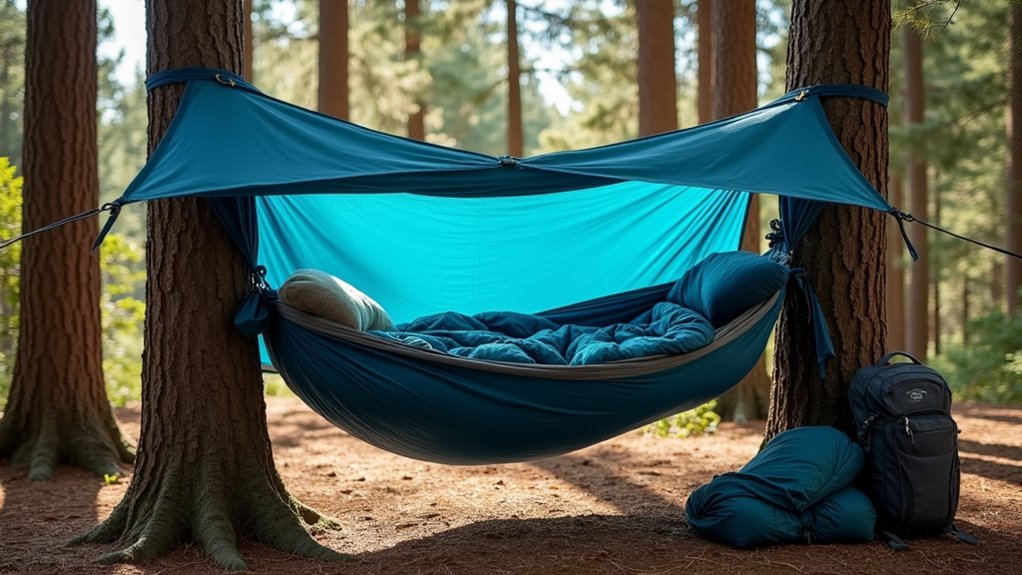
Transform your camping experience with these hammock setup secrets that'll keep you dry, cozy, and floating above ground-level discomfort.
You might be surprised to learn that hammock camping can actually be more comfortable than tent camping, as you’ll never have to worry about sleeping on rocky or uneven ground. If you’re looking to lighten your pack weight and enhance your outdoor experience, hammock camping offers a practical alternative that won’t break the bank. While the setup may seem straightforward, there are essential details you’ll need to master to guarantee a safe, dry, and cozy night under the stars.
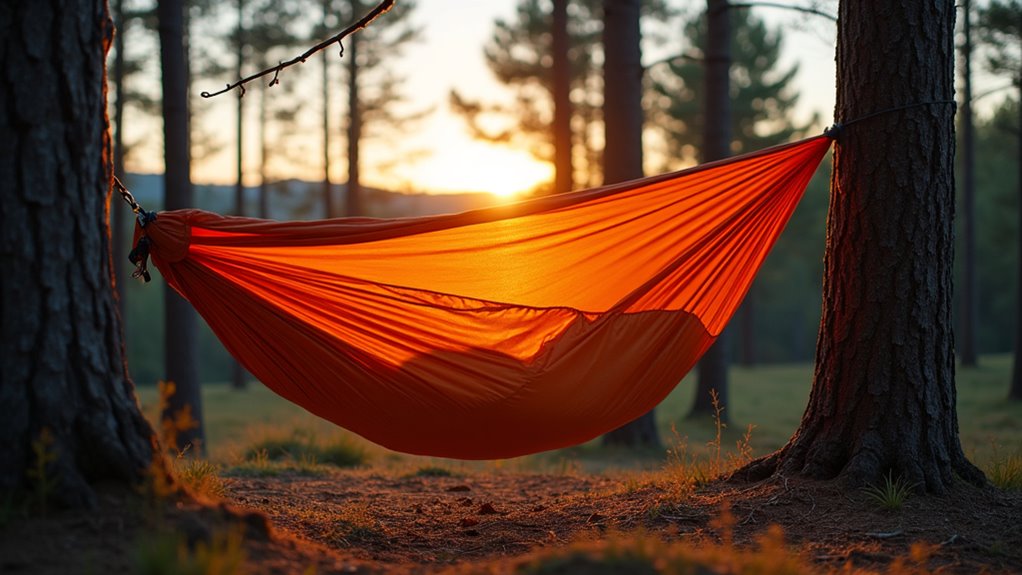
A well-equipped hammock camping setup starts with five core essentials: the hammock body, suspension system, tarp, hardware, and stuff sack.
You’ll need proper suspension components including webbing straps to protect trees, continuous loops, and whoopie slings for adjustability. Don’t skimp on the tarp – it’s your primary shelter from the elements. Mastering the art of hammock camping can enhance your overall experience.
For the hardware, invest in quality carabiners and clips that won’t fail when you need them most. Adding a structural ridgeline helps maintain optimal sag and supports bug nets or top covers.
While many hammocks come with a basic stuff sack, you might want to upgrade to one that’s waterproof and appropriately sized for your gear.
Selecting the right location for your hammock camp requires careful attention to both safety and practicality. Look for healthy trees at least 6 inches in diameter, spaced 14-16 feet apart for ideal hanging. You should aim to position your setup at least 200 feet from water sources while avoiding cliffs and animal trails. Make sure to maintain a 30-degree angle when setting up your suspension system for optimal stability and comfort.
Solar showers can make your camping experience more refreshing. Before setting up, verify you’ve got proper permits and you’re following all local campground rules and Leave No Trace principles.
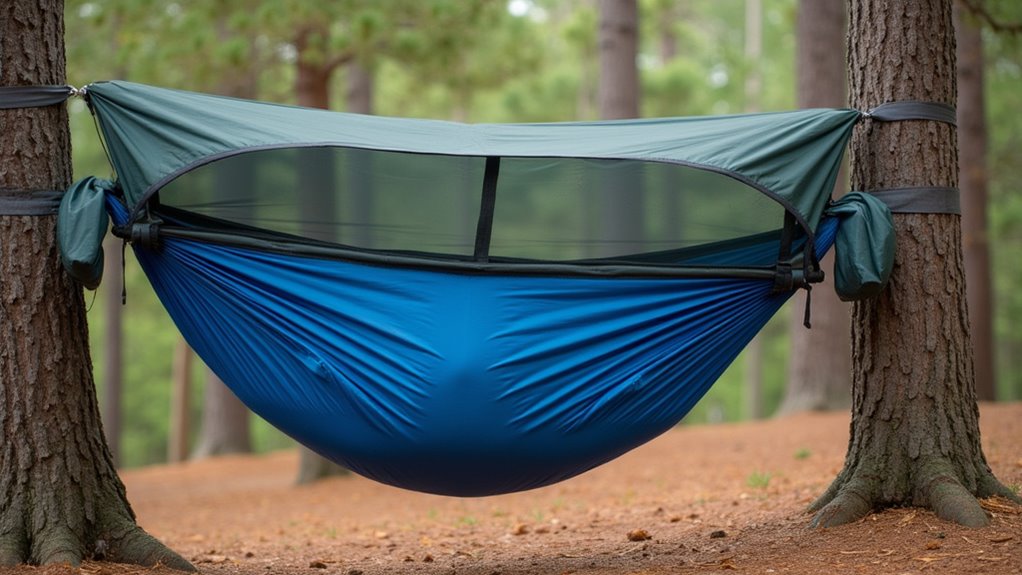
Proper hammock setup begins with identifying two healthy trees spaced 12-16 feet apart. Check each tree for stability, ensuring they’re at least 6 inches in diameter and free from decay or dead limbs.
Start by wrapping tree straps around your chosen trees at about 6 feet high. Attach your suspension hardware to the straps following the manufacturer’s guidelines. For detailed visual guidance, you can visit The Ultimate Hang YouTube channel for step-by-step tutorials.
Proper strap placement at 6 feet height, combined with secure hardware attachment, creates the foundation for safe hammock camping.
Lay out your hammock and connect it to the suspension system, aiming for a 30-degree angle from horizontal. You’ll want enough sag in the middle for comfort, with about 18 inches of ground clearance when loaded. Choosing the right camping furniture can further enhance your outdoor experience.
Test the setup by sitting in it carefully, then make adjustments to achieve your desired firmness. Don’t forget to check all connections periodically and clear any debris from beneath your hammock for safety.
Whether you’re camping in light drizzle or heavy storms, effective weather protection starts with your tarp configuration. Position your rain fly at least 12 inches beyond each hammock end and hang it slightly lower than your hammock for ideal coverage. Choose waterproof materials like nylon or polyester, and make certain your tarp remains taut to prevent water pooling and wind damage. Drip lines prevent water from seeping down your suspension straps into the hammock system.
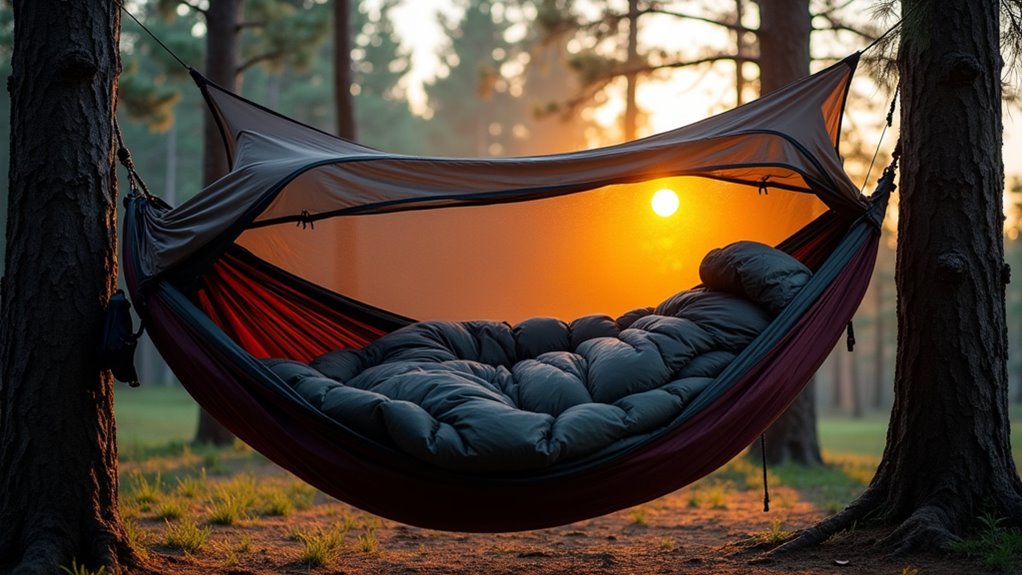
As temperatures drop at night, maintaining warmth in your hammock requires a strategic approach to insulation and layering. Start with a quality underquilt to insulate your hammock’s bottom and sides, then add a sleeping pad for extra protection against cold air. Consider adding emergency blankets to reflect and retain your body heat more effectively.
Layer your clothing with moisture-wicking base layers and warm insulating pieces. Create a cocooned sleeping environment by using bungee cords to wrap the hammock snugly around you, and don’t forget to protect your extremities with insulated gloves, socks, and a warm hat. Camping air beds are a must-have for outdoor comfort and can provide additional insulation and support in your hammock setup.
Place hot water bottles near your core for immediate warmth, and position your hammock setup to minimize wind exposure. Choose elevated spots away from low-lying areas where cold air settles, and use tarps to create a protected microclimate around your sleeping space.
Safety remains paramount when hammock camping, requiring careful attention to both location selection and equipment setup. Choose healthy, thick trees or solid posts for hanging, and keep your hammock height no more than 3 feet off the ground. When setting up your campsite, make sure to position yourself away from food and water sources to minimize wildlife encounters.
Always inspect your gear before use, follow weight limits strictly, and avoid risky behaviors like stacking hammocks or swinging vigorously.
Stay alert to changing weather conditions and maintain clear evacuation routes from your campsite for unexpected emergencies. Plus, be prepared for cold-weather camping by packing the necessary gear and clothing.
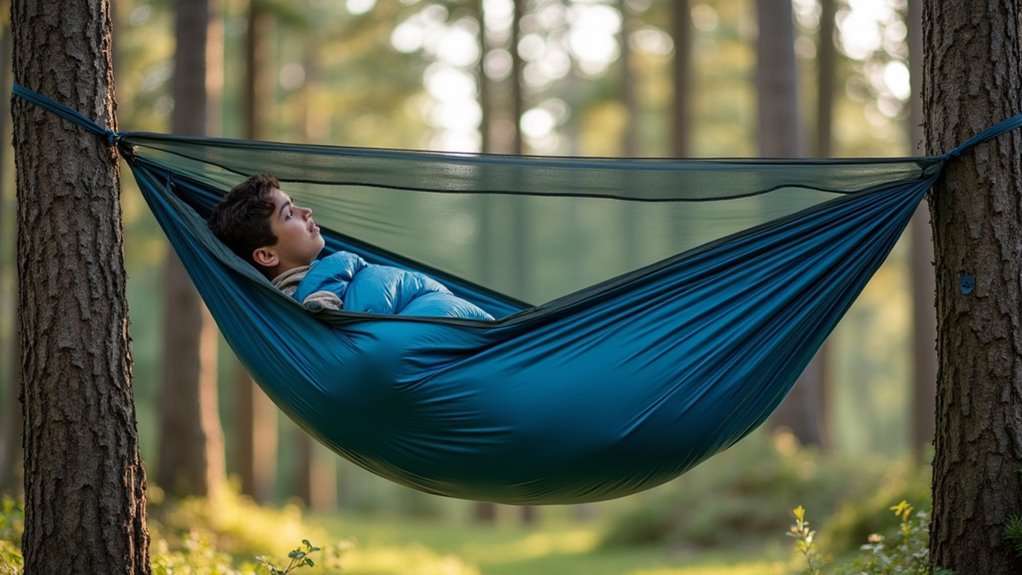
Before commencing your first hammock camping adventure, taking time to practice and prepare will greatly increase your chances of success.
Set up your hammock in your backyard or a local park to test its comfort and guarantee you’ve got the proper hanging technique down. Five minutes is all you need for a complete setup once you’re familiar with your gear.
Bring a tent as backup on your first trip in case you encounter setup difficulties or discover the hammock isn’t right for you.
When choosing your campsite, look for healthy trees spaced appropriately for your hammock’s length. Embrace comfort is a wise option for jungle camping.
Practice the diagonal lay position (10-15 degrees off-center) to achieve maximum comfort and prevent the cocoon effect.
Remember to hang your straps about 5-6 feet high, maintaining a 30-degree angle for proper suspension.
Use tree-saver straps to protect the bark and follow Leave No Trace principles by camping at least 200 feet from water sources.
Like Odysseus finding comfort in the simplest of places, you’ll discover hammock camping offers an affordable and liberating way to experience nature. You’ve now got the essential knowledge to hang safely, stay dry, and sleep comfortably above the ground. Remember to practice your setup at home, respect the environment, and start with fair-weather trips. With these skills, you’re ready to join the growing community of hammock camping enthusiasts.